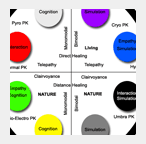Telepathy
Parapsychology Articles, Papers and Books
Home > Articles > Psychical Phenomena > Extrasensory Perception > Telepathy
![]()
|
| NEWSLETTERS |
| Get the best from QPsychics.com in your inbox! |
|
| PARAPSYCHOLOGY ORGANIZATIONS |
"With confidence in the importance of utilizing the investigative mode of the established sciences in order to inquire into the authenticity and to potentially explain the nature of psychical phenomena."  |
 |
 |
 |
 |
The Stages of Telepathic Simulation
Telepathy is the psychical influence of thought via experient influence over the biological basis of consciousness and the mental process by which we perceive, act, learn and remember; Including mental forms and processes such as the nervous system in which processes and transmits information by electrochemical signaling. In regards to intentional telepathic simulation techniques, several stages are assumed to exist through which the telepathist shares information. During spontaneous (non-intentional) telepathic simulation, these processes are assumed to run automatically by the subconscious. However, since the processes are run subconsciously, there is no conscious directive.†To obtain a level of conscious direction, the telepathist is assumed to require achieving each step in order to perform successfully.
Physical interaction is achievable via any action through which the telepathist and subject(s) has an effect upon one and other. This two-way effect, or interconnectivity, is assumed essential for telepathic simulative processes. Examples of types of interaction can include communication between participants of any kind (e.g. talking), close spatial proximity, or direct physical touch.
(Adapted from the book ďTelepathy: A Quantum ApproachĒ by Theresa M. Kelly, MsD.)
|
|||
Related Articles |
|||

